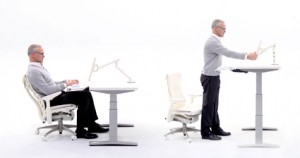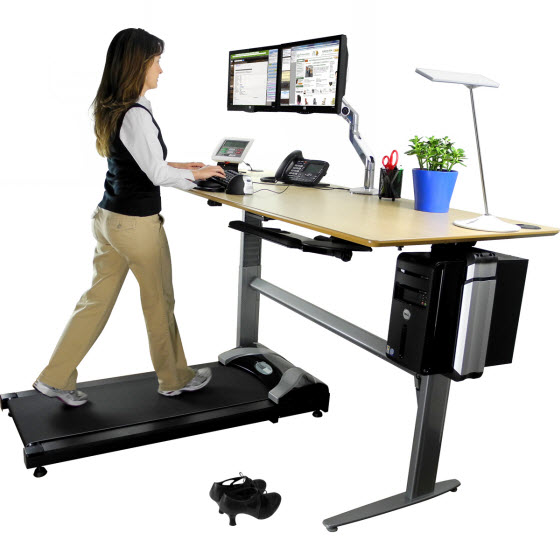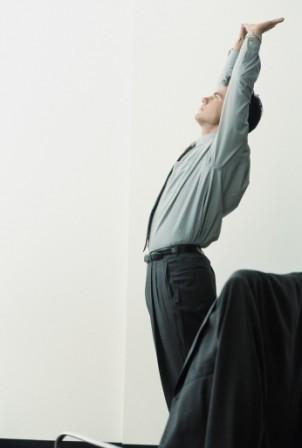Prolonged Sitting at Work: Hazardous to Your Health
Workers who spend extended amounts of time sitting risk poor health outcomes. On average, we sit from 8 to 15 hours a day. A 2013 Australian study found that too much sitting is “adversely associated with …. cardio-metabolic risk biomarkers, type 2 diabetes, and premature mortality.1 Another recent study also found that workers with high levels of sitting time were “9.0 times more likely to have a Body Mass Index greater than 30 (Obese)”.2
There are ways to lessen sedentary behavior at the workplace from changing your desk furniture to getting out of your workspace and exercising.
Active Workstations
To reduce sitting time, many workplaces provide
- Sit-Stand Desks- adjustable-height desks that convert from sitting to standing and back
- Treadmill Workstations- addition of a treadmill under adjustable-height desks
 A 2012 study found that young adults using a sit-stand desk expended significantly more calories than those seated at a traditional desk.3 Another study discovered that using a sit-stand desk reduced sitting time by 224% (66 minutes per day), reduced upper neck and back pain by 54%, and improved mood states. Removal of the sit-stand desk “negated all observed improvements within two weeks.”4
A 2012 study found that young adults using a sit-stand desk expended significantly more calories than those seated at a traditional desk.3 Another study discovered that using a sit-stand desk reduced sitting time by 224% (66 minutes per day), reduced upper neck and back pain by 54%, and improved mood states. Removal of the sit-stand desk “negated all observed improvements within two weeks.”4
 Using a treadmill workstation “favorably influenced waist and hip circumferences and lipid and metabolic profiles in overweight and obese office-workers.”5 Another study reports that “if obese individuals were to [switch to treadmill workstations] a weight loss off 44-66 pounds could occur.”6 Walking on a treadmill while working “did not affect attention and processing speed, or reading comprehension.”7 But another study notes that more than four hours of training are needed by new users of treadmill workstations, or there will be a significant drop in productivity.8 Also, treadmill stations may be less suitable for mouse-intensive work.9
Using a treadmill workstation “favorably influenced waist and hip circumferences and lipid and metabolic profiles in overweight and obese office-workers.”5 Another study reports that “if obese individuals were to [switch to treadmill workstations] a weight loss off 44-66 pounds could occur.”6 Walking on a treadmill while working “did not affect attention and processing speed, or reading comprehension.”7 But another study notes that more than four hours of training are needed by new users of treadmill workstations, or there will be a significant drop in productivity.8 Also, treadmill stations may be less suitable for mouse-intensive work.9
If your workplace is unable to provide you with an active workstation, there are still things you can do to reduce sitting time:
Exercise at Your Desk or Station:
 Stand and stretch for at least one minute every 20 minutes. Standing increases energy, burns extra calories, tones muscles, improves posture, increases blood flow and ramps up metabolism10
Stand and stretch for at least one minute every 20 minutes. Standing increases energy, burns extra calories, tones muscles, improves posture, increases blood flow and ramps up metabolism10 - Stand by your chair and do lunges or march in place for at least one minute every hour
Workplace Exercises:
- Walk to the other side of the building and back
- Walk to a coworker’s desk to ask a question instead of emailing
- Go up and down a nearby flight of stairs
- Use a printer that’s the farthest away from your desk
- Initiate a “walking meeting” or take a walk during lunch with coworkers
Curious How Long You Sit Each Day? Calculate Your Sitting Time: http://www.juststand.org/Tools/SittingCalculator/tabid/866/language/en-US/Default.aspx
1Too Much Sitting- A Health Hazard. Sep 2012. Diabetes Research and Clinical Practice 97(3): 368-76.
2Desk-Based Occupational Sitting Patterns: Weight-Related Health Outcomes. Oct 2013. American Journal of Preventive Medicine 45(4): 448-52.
3Difference in Caloric Expenditure in Sitting vs Standing Desks. Sep 2012. Journal of Physical Activity & Health 9(7): 1009-11.
4Reducing Occupational Sitting Time and Improving Worker Health: The Take-a-Stand Project, 2011. Oct 2012. Preventing Chronic Disease 9:E154.
5Treadmill Workstations: A Worksite Physical Activity Intervention in Overweight and Obese Office Workers. Nov 2011. Journal of Physical Activity & Health 8(8): 1034-43.
6The Energy Expenditure of Using a “Walk and Work” desk for Office Workers with Obesity. Sep 2007. British Journal of Sports Medicine 41(9): Article Number 558.
7Effect of Using a Treadmill Workstation on Performance of Simulated Office Work Tasks. Sep 2009. Journal of Physical Activity & Health 6(5): 617-24.
8Productivity of Transcriptionists Using a Treadmill Desk. 2011. Work: A Journal of Prevention Assessment & Rehabilitation 40(4): 473-7.
9 The Effects of Walking and Cycling Computer Workstations on Keyboard and Mouse Performance. Oct 2013. Human Factors 55:911-23.
10The Facts: What We Know About Sitting and Standing. http://www.juststand.org/tabid/816/default.aspx